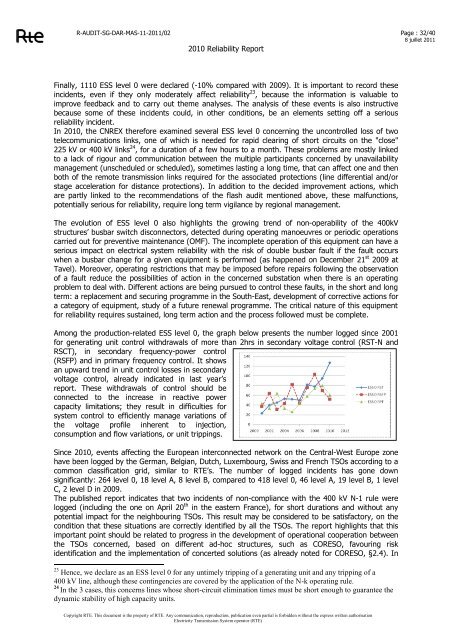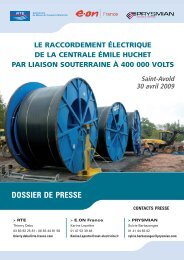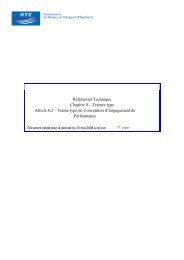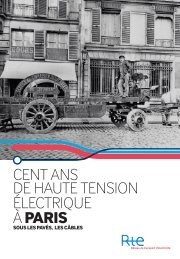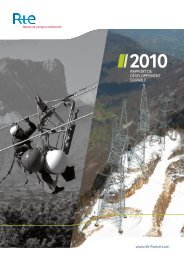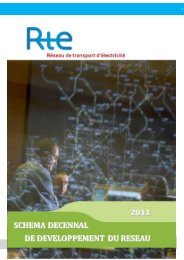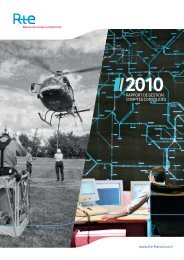Power System Reliability Report - RTE
Power System Reliability Report - RTE
Power System Reliability Report - RTE
- No tags were found...
Create successful ePaper yourself
Turn your PDF publications into a flip-book with our unique Google optimized e-Paper software.
R-AUDIT-SG-DAR-MAS-11-2011/022010 <strong>Reliability</strong> <strong>Report</strong>Page : 32/408 juillet 2011Finally, 1110 ESS level 0 were declared (-10% compared with 2009). It is important to record theseincidents, even if they only moderately affect reliability 23 , because the information is valuable toimprove feedback and to carry out theme analyses. The analysis of these events is also instructivebecause some of these incidents could, in other conditions, be an elements setting off a seriousreliability incident.In 2010, the CNREX therefore examined several ESS level 0 concerning the uncontrolled loss of twotelecommunications links, one of which is needed for rapid clearing of short circuits on the "close"225 kV or 400 kV links 24 , for a duration of a few hours to a month. These problems are mostly linkedto a lack of rigour and communication between the multiple participants concerned by unavailabilitymanagement (unscheduled or scheduled), sometimes lasting a long time, that can affect one and thenboth of the remote transmission links required for the associated protections (line differential and/orstage acceleration for distance protections). In addition to the decided improvement actions, whichare partly linked to the recommendations of the flash audit mentioned above, these malfunctions,potentially serious for reliability, require long term vigilance by regional management.The evolution of ESS level 0 also highlights the growing trend of non-operability of the 400kVstructures‟ busbar switch disconnectors, detected during operating manoeuvres or periodic operationscarried out for preventive maintenance (OMF). The incomplete operation of this equipment can have aserious impact on electrical system reliability with the risk of double busbar fault if the fault occurswhen a busbar change for a given equipment is performed (as happened on December 21 st 2009 atTavel). Moreover, operating restrictions that may be imposed before repairs following the observationof a fault reduce the possibilities of action in the concerned substation when there is an operatingproblem to deal with. Different actions are being pursued to control these faults, in the short and longterm: a replacement and securing programme in the South-East, development of corrective actions fora category of equipment, study of a future renewal programme. The critical nature of this equipmentfor reliability requires sustained, long term action and the process followed must be complete.Among the production-related ESS level 0, the graph below presents the number logged since 2001for generating unit control withdrawals of more than 2hrs in secondary voltage control (RST-N andRSCT), in secondary frequency-power control(RSFP) and in primary frequency control. It showsan upward trend in unit control losses in secondaryvoltage control, already indicated in last year‟sreport. These withdrawals of control should beconnected to the increase in reactive powercapacity limitations; they result in difficulties forsystem control to efficiently manage variations ofthe voltage profile inherent to injection,consumption and flow variations, or unit trippings.Since 2010, events affecting the European interconnected network on the Central-West Europe zonehave been logged by the German, Belgian, Dutch, Luxembourg, Swiss and French TSOs according to acommon classification grid, similar to <strong>RTE</strong>‟s. The number of logged incidents has gone downsignificantly: 264 level 0, 18 level A, 8 level B, compared to 418 level 0, 46 level A, 19 level B, 1 levelC, 2 level D in 2009.The published report indicates that two incidents of non-compliance with the 400 kV N-1 rule werelogged (including the one on April 20 th in the eastern France), for short durations and without anypotential impact for the neighbouring TSOs. This result may be considered to be satisfactory, on thecondition that these situations are correctly identified by all the TSOs. The report highlights that thisimportant point should be related to progress in the development of operational cooperation betweenthe TSOs concerned, based on different ad-hoc structures, such as CORESO, favouring riskidentification and the implementation of concerted solutions (as already noted for CORESO, §2.4). In23 Hence, we declare as an ESS level 0 for any untimely tripping of a generating unit and any tripping of a400 kV line, although these contingencies are covered by the application of the N-k operating rule.24In the 3 cases, this concerns lines whose short-circuit elimination times must be short enough to guarantee thedynamic stability of high capacity units.Copyright <strong>RTE</strong>. This document is the property of <strong>RTE</strong>. Any communication, reproduction, publication even partial is forbidden without the express written authorisationElectricity Transmission <strong>System</strong> operator (<strong>RTE</strong>)


